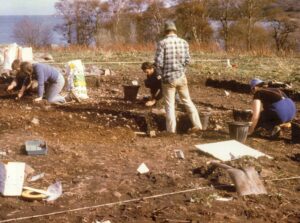
Someone got me thinking recently about the way in which destruction is embedded in archaeology. This occurs in three ways. And I find it rather fascinating.
Firstly, an element of destruction is necessary in order to turn anthropogenic material into an archaeological site. Thus, your active house, burial, fireplace, or pit not only goes out of use, it becomes buried by sediments and is often damaged in the process. It is rare for the traces of past human activity to sit on the surface of the ground, totally pristine, waiting for excavation. There are a whole range of processes, human and natural, that will impact on it and both diminish it and add to it. Erosion may truncate and diminish it; sedimentation may cover and add to it. In the process, original material often becomes muddled and, inevitably, acidic soils and other processes will dissolve and obliterate the more fragile elements such as organic elements like bone.
Thus, an archaeological site is born from destruction.
Secondly, the archaeological site is never stable. There are processes of change that operate across the surface of the earth and work, constantly, to reshape its individual features and elements. This is known as taphonomy. It impacts on the archaeological site with a destructive force that may be slow or fast. Thus, remains become disordered. Some sites may be well preserved, others severely disturbed, but all are unquestionably diminishing. A scatter site becomes more scattered, a coastal site eroded, buried sites compress and unravel. In recent millennia, human actions compound the picture. The archaeologist, coming across a site and deciding to excavate it, interrupts these processes and part of our essential skills lies in unpicking and defining the stages of destruction through which the site has passed. The study of the taphonomy of any individual site is important because it helps us to understand the formation of the site and, thus, its original nature.
Thus, an archaeological site is nurtured by destruction.
Thirdly, the archaeologist, themself, will, in excavation, destroy those final archaeological remains. Excavation is a destructive process. The painstaking recording and removal of the traces of past human activity will, if undertaken to completion, result in the obliteration of the site itself. True, the individual elements will survive, as assemblages of flint or pottery, bags of charcoal, even carefully curated masonry or wood. But the site will be no more. Even where a site is simply recorded and managed with a view to preserving its long-term future, this cannot be for ever. Uncovery often precipitates destabilization. And of course, many sites simply disappear without recording or excavation. Nature helps us there.
Thus, an archaeological site is ended by destruction.
Of course, the human eye does not perceive these processes as an immediate problem. We are trained to do our jobs and we do them well. We practice the skills of archaeology and tease out the details that we need to understand the past, while managing and preserving as much as we can. But in the grand scale of things our efforts are meaningless. In global terms the safe storage of our best museums is no more long-term than the lifetime of our cities and civilizations. Inexorably, the world will change. And in recent years we have, perhaps, become a little more attuned to the nature of that change, especially given our best efforts to speed it up.
I’ve been writing a document and I had been using the term ‘destruction’ rather loosely. I was picked up on that, and I am glad about it. It got me thinking. I’m wondering about the word ‘destruction’. We generally give it very negative overtones. But, in an archaeological sense, perhaps destruction is not so much negative as inevitable. You could argue that it is constructive: the process by which archaeology becomes available and by which we can study it.
Destruction as an inherent part of the world and one which we need to learn to embrace – discuss. Now there is an undergraduate essay title, sadly one I never thought of when teaching!
You must be logged in to post a comment.